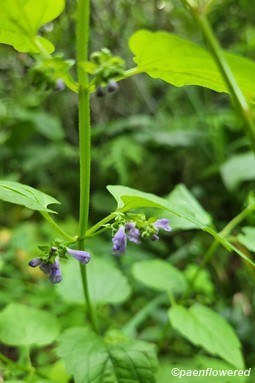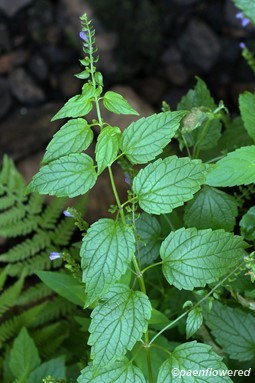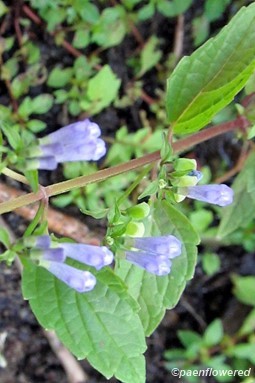Scutellaria lateriflora
A skullcap with smallish blue/lavender flowers grouped in one-sided racemes
Scutellaria lateriflora blue skullcap
The skullcap species are members of the mint family and thus have square stems. Unlike other mints, the stem is hairless. Their leaves occur in pairs and the flowers are lipped and hooded and have a tubular corolla. The flowers are violet or blue. This particular native, perennial species, the blue skullcap, is easily identified because the small flowers are in slender, one-sided racemes that arise from the leaf axils. Each flower is about ⅓ inch long, the smallest flower of the skullcap group. Usually, only a few are in bloom at any one time.
The fruit is a capsule with two lobes. The leaves are up to three inches long and two inches wide and coarsely toothed. There is a strong pattern of veins in the leaf. It grows in rich thickets, meadows, marshes, and wet woods throughout eastern North America. The plant grows 1-3 feet high and blooms from June to October. Mammal herbivores will not eat it because of the bitter taste. In herbal medicine, this species was used as a sedative and promoter of sleep. One scientific small-scale study showed it had some ability to reduce anxiety. One of the common names of this plant (mad-dog skullcap) comes from the early mistaken belief that it could cure rabies.
Habitat & Range
Common in wet woods, bogs, lake margins, stream banks, floodplains, and swampy pastures. Prefers some shade to full sun and wet to moist conditions.
Present throughout the state.
| EMP: | FACW |
|---|---|
| NCNE: | OBL |
Phenology
Flowers late June to early October.
Characteristics
Flowers blue to violet, rarely pinkish or white; tubular, 2-lipped corolla; 2-lipped calyx;
Inflorescence 1 to 4 inches long; one-sided raceme arising from leaf axils
Leaves opposite, in pairs; broadly lance-shaped, coarsely serrate; up to 2.8 inches long
Stem smooth or slighly pubescent on the angles
Fruit dry, spherical, brown capsule with 4 nutlets
Height 1 to 3 feet
Plant Codes
S-rank: No rank
G-rank: G5 (Secure)
Medicinal Qualities
Native Americans used this plant as a sedative and to promote menstruation. In today's herbal medicine the plant is still used to prevent epileptic seizures.
Ecology
Pheasants eat the seeds, caterpillars feed on the leaves.







Comments
Have you spotted this plant in your area? We'd love to hear about your experience! Share your comments or questions about the plant below. Comments are moderated before posting.